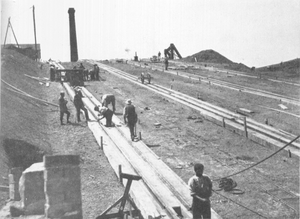Foxton Inclined Plane facts for kids
Quick facts for kids Foxton Inclined Plane |
|
|---|---|

Inclined Plane from the top
|
|
| Type | canal inclined plane |
| Location | Leicestershire, England |
| Elevation | 75 ft (23 m) |
| Construction | 1898-1900 |
| Built for | Grand Union Canal |
| Demolished | 1926 |
| Restored | 2008 |
| Architect | Gordon Cale Thomas |
| Owner | Canal & River Trust |
| Official name: Inclined Plane immediately east of Foxton Locks | |
| Designated | 24 January 1973 |
| Reference no. | 1018832 |
| Lua error in Module:Location_map at line 420: attempt to index field 'wikibase' (a nil value). | |
The Foxton Inclined Plane was a clever machine built to help boats move up and down a big hill on the Grand Union Canal. It is located about 5 kilometers (3 miles) west of Market Harborough in Leicestershire, England. It is named after the nearby village of Foxton.
This special plane was built in 1900. It was designed to solve problems with the Foxton Locks, which were too narrow for bigger boats. Even though it was a great idea, it only worked full-time for ten years. The plane was taken apart in 1926. Today, there is a project to rebuild it. This is because the narrow locks still cause delays for leisure boats.
Contents
History of the Foxton Inclined Plane
Around 1897, the company that owned the Grand Union Canal wanted to help bigger boats travel along the Leicester line. The old locks were only wide enough for narrow boats. So, they decided to build something new.
Their solution was to build an inclined plane right next to the locks. The company first planned for the plane to replace the locks completely. However, it ended up being a faster second option. Building the plane started in 1898 and was finished by July 10, 1900.
How the Inclined Plane Worked
The plane was designed by Gordon Cale Thomas. He first built a small model to test his ideas. The plane had two large tanks, called caissons. Each caisson could hold two narrowboats or one larger barge. These water-filled tanks balanced each other as they moved. Special gates on the caissons kept the water inside.
A powerful 25-horsepower (19 kW) steam engine provided the power for the lift. The land for the plane cost £1,595. The total cost to build the entire project was £39,244 by June 1900.
Benefits and Challenges
Using the inclined plane was much faster than the locks. It took only 12 minutes for two boats to go up and two to go down. This was a huge improvement compared to the 1 hour and 15 minutes it took using the locks. In a 12-hour day, the plane could move 6,000 tons (6,100 tonnes) of cargo.
Another big advantage was water saving. When boats go through locks, a lot of water flows downhill and is lost. With the inclined plane, almost the same amount of water went up and down. Only the water pushed aside by the boats was moved. This saved a lot of water, which was very important for the canal.
One early problem was the stress on the tracks from the heavy caissons. There was a plan to build another similar inclined plane at the Watford Locks. However, this never happened. Because the Watford Locks were never made wider, the Foxton Inclined Plane could not be used to its full potential.
Keeping the steam engine running all the time, just in case boats arrived, also cost a lot of money. So, even though it worked well, the Foxton Inclined Plane was stopped in 1911 to save money. After that, it was only used sometimes, usually when the locks needed repairs.
In 1926, the machinery of the inclined plane began to be taken apart. It was sold for scrap in 1928 for only £250. The chimney of the engine house was pulled down that same year. Its bricks were used to fix other parts of the canal. You can still find the old mooring posts from the plane near the locks today.
Preserving the Foxton Inclined Plane
The Foxton Canal Museum is located in the old boiler house of the plane's steam engine. The museum tells the story of the locks and the inclined plane. It also shares information about the lives of the canal workers and other local canal history. The museum opened in 1989.
Restoration Efforts
The site of the Foxton Inclined Plane Boat Lift is now a protected historical site. It was once on a list of monuments at risk of decay. This recognition, along with more people using British canals for fun, means restoring the plane is seen as a very important project for the national waterway network. In 2006, the full restoration was estimated to cost £9 million.
The first part of the restoration project was finished in 2008. This involved clearing the site and fixing the canal sections above and below the plane. A grant of £1.7 million was received from the Heritage Lottery Fund for this first stage, which cost £2.8 million. Because this first stage was successful, the site was removed from the Monuments at Risk list.



